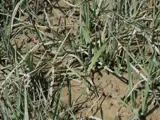 Spartina
Spartina
Common name: Spartina
Botanical name: Spartina anglica, S. alterniflora
Management programme: Eradication
Spartina is native to North America and England. It was introduced to New Zealand deliberately to help bind sediment to reclaim estuaries and bind stop banks that were eroding in order to extend areas for grazing stock.
Why is it a pest?
- Fast growing, spreading through underground rhizomes and smothering out native plants.
- Forms large clumps that hold on to sediment, altering natural flushing cycles of the estuary habitat.
- Takes away habitat for important estuary species such as wading birds, fish and invertebrates.
Where is it found?
Spartina can be found in inter-tidal zones of coastlands and wetlands. In the Bay of Plenty it is found in small patches in Maketū estuary and Tauranga Harbour.
What does it look like?
- Spartina is a clumping grass that grows about a metre high.
- Leaves are smooth to the touch and feel smooth when running your fingers back and forth, unlike grasses which feel rough one way.
- Leaves are ribbed on the tips.
- Flowers appear in groups at the tip of the plant.
- Stalks are very erect and thick when compared to other estuary grasses.
- Spartina alterniflora has a brownish/reddish colour to the stems. Spartina anglica has a greenish/blueish colour to the stems.
What are the rules?
Eradication
Eradication pests are present in the region but are limited in their size or extent of infestation. The eradication of these organisms is a feasible and cost-effective solution. The Bay of Plenty Regional Council is responsible for their control or eradication from the region. Action may be required from landowners or occupiers to support a control operation.
Note: Council will maintain control and management of Spartina. It is a very high risk plant and requires intensive monitoring and control.
How do you get rid of it?
Please do not attempt to control this plant yourself. If you think you have found Spartina, please contact the Bay of Plenty Regional Council.
Images





